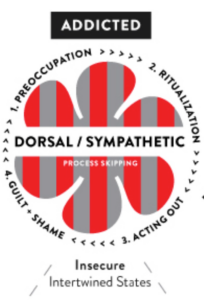By Dr. Leslie Ellis
Just at a time when the wider world is waking up to a more compassionate and inclusive way of understanding trauma and addiction, a timely book that addresses these issues in personal, historical, embodied, and practical ways has arrived. In Treating Trauma and Addiction with the Felt Sense Polyvagal Model: A Bottom-Up Approach (Routledge, 2021), author and psychotherapist Jan Winhall both demystifies and depathologizes addiction. She does so by demonstrating in theory and with compelling case studies how addictive behaviours are in fact resourceful attempts to regulate a body that has been thrown out of homeostatic balance by traumatic experience.
Winhall’s new book incorporates both focusing and the polyvagal theory to create a treatment model that is both effective and humane. It’s a model to help those afflicted with addictions and other effects of trauma understand their own physiological and emotional responses and begin to take steps toward change that are both self-compassionate and doable.
 Winhall explains how addiction is a propeller of neurophysiological state change, and in doing so, she solves the mystery of addictive behavior that often puzzled her as a young therapist. She begins with a compelling story of her first women’s group and the mystery of their deeply self-harming behaviors. At the time, she simply couldn’t understand why this fascinating group of young incest survivors engaged in such self-destructive acts. Rejecting the idea that they were simply damaged, broken and ‘borderline’, Winhall went on a decades-long hunt for a more compassionate understanding of how to help these women heal.
Winhall explains how addiction is a propeller of neurophysiological state change, and in doing so, she solves the mystery of addictive behavior that often puzzled her as a young therapist. She begins with a compelling story of her first women’s group and the mystery of their deeply self-harming behaviors. At the time, she simply couldn’t understand why this fascinating group of young incest survivors engaged in such self-destructive acts. Rejecting the idea that they were simply damaged, broken and ‘borderline’, Winhall went on a decades-long hunt for a more compassionate understanding of how to help these women heal.
A consistent thread through the book is Jan’s story of her own development as a trauma therapist. It illustrates an evolution of ideas about the etiology and treatment of trauma over the past 40 years. Early influences include Ellen Bass and Laura Davis’ (1988) The Courage to Heal, and Judith Herman’s (1992) classic, Trauma and Recovery. Add to this mix a deep understanding of Eugene Gendlin’s focusing, which brings a method of listening to the body in a manner that assumes it knows the way forward. Stir in a healthy grounding in Dan Siegel’s interpersonal neurobiology, John Bowlby’s attachment theory, the compassionate views of Gabor Maté, the relational wisdom of Harville Hendrix and Helen LaKelly Hunt, and finally, the updated understanding of the nervous system’s response to threat and connection as proposed in Stephen Porges’ polyvagal theory.
When you combine all these embodied, compassionate approaches to working with trauma and addiction, what emerges is a model that stands in stark contrast to the medicalized version that pathologizes those who have already suffered so greatly. As Jan so aptly demonstrates, those who suffer trauma(s) and subsequently engage in a range of addictive behaviours are not broken, but in fact, are doing their best to manage their pain and overwhelming emotions in the ways that are most available to them. It reframes their stories from tales of illness to journeys of triumph and liberation.
To read Dr. Ellis’ review, please click here to download the PDF
Photo credit: Man in Mirror: Image by Med Ahabchane from Pixabay







